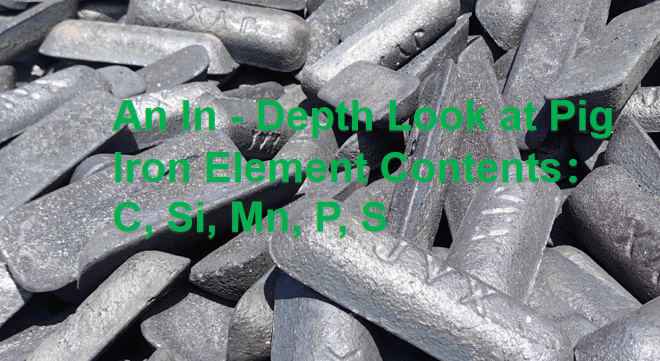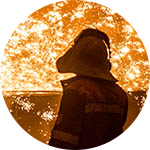An In - Depth Look at Pig Iron Element Contents:C, Si, Mn, P, S
2025-07-08 09:13:46 hits:0
In the iron and steel industry system, pig iron serves as the basic raw material for steelmaking and casting, and its quality and performance have a decisive impact on subsequent products. The properties of pig iron are determined by its internal chemical composition. The contents and interactions of elements such as carbon, silicon, manganese, phosphorus, and sulfur jointly shape the characteristics of pig iron. A series of national standards formulated in China for pig iron provide authoritative specifications for pig iron production and quality control. For example, the Regulatory Conditions for the Identification of Pig Iron Enterprises for Foundry clearly defines the chemical composition standards that pig iron for gray cast iron parts and nodular cast iron should follow (For details, see: https://www.gov.cn/zwgk/2011-04/02/content_1837093.htm).

I. Carbon Content in Pig Iron: The Core Factor Affecting Performance
1.1 Content and Forms
Carbon is the element with the highest content in pig iron, usually ranging from 3.5% to 4.5%. According to relevant Chinese national standards, the carbon content of pig iron used for the production of gray cast iron parts shall not be lower than 3.30%; for pig iron used for nodular cast iron, the carbon content is required to be not less than 3.40%. In pig iron, carbon mainly exists in two forms: cementite (Fe₃C) and graphite.
1.2 Influence on Performance
A higher carbon content endows pig iron with good casting properties. Carbon can reduce the melting point of pig iron and improve the fluidity of molten iron, making it easier to fill complex mold cavities during the casting process and meet the production requirements of complex castings such as large machine tool bases and automobile engine blocks. However, an excessively high carbon content will lead to an increase in cementite in pig iron, resulting in increased hardness, brittleness, and reduced toughness and plasticity, making it unsuitable for structural parts with high toughness requirements.
1.3 Role in Steelmaking
During the steelmaking process, carbon reacts with oxygen to release heat, providing the required energy for steelmaking. Although the national standard does not take the carbon content as the rejection basis for pig iron used in steelmaking, it is usually ensured that the carbon content is ≥3.50% to ensure the smooth progress of subsequent steelmaking processes and the production of qualified steel (For details of the national standard for pig iron used in steelmaking, refer to: https://m.baike.com/wiki/%E7%82%BC%E9%92%A2%E7%94%A8%E7%94%9F%E9%93%81%EF%BC%88GB%2FT1717/2213289?baike_source=doubao).
II. Silicon Content in Pig Iron: The Key Element Promoting Graphitization
2.1 Content Range
The silicon content in pig iron generally ranges from 0.8% to 3.0%. According to Chinese standards, the silicon content of pig iron for gray cast iron parts should be not less than 1.25%, and that of pig iron for nodular cast iron should be controlled between 0.50% and 1.40%.
2.2 Function in Pig Iron
Silicon can promote graphitization during the solidification process of pig iron and inhibit the formation of cementite. An appropriate amount of silicon can further enhance the fluidity of molten iron, reduce the tendency of castings to produce white - structure, and lower the risk of cracks. At the same time, silicon reacts with oxygen at high temperatures to form a dense oxide film on the surface of pig iron, improving its heat resistance and oxidation resistance.
2.3 Impact of Excessive Content
However, an excessively high silicon content will increase the hardness and brittleness of pig iron and reduce its toughness and machinability. Therefore, during production, the silicon content needs to be precisely controlled according to product requirements. For example, appropriately increasing the silicon content in the production of gray cast iron can optimize the morphology and distribution of graphite, while in the production of nodular cast iron, the silicon content needs to be strictly controlled to ensure the spheroidization effect and casting quality.
III. Manganese Content in Pig Iron: An Important Assistant for Deoxidation and Desulfurization
3.1 Classification by Content
The manganese content in pig iron usually ranges from 0.5% to 1.5%. According to different usage requirements, Chinese pig iron standards divide the manganese content of pig iron for steelmaking into three groups: Group 1 ≤ 0.40%, Group 2 > 0.40% - 1.00%, and Group 3 > 1.00% - 2.00%.
3.2 Roles in Smelting
In the high - temperature environment of pig iron smelting, manganese reacts with oxygen to form manganese oxide (MnO), playing a role in deoxidation. This can reduce defects such as pores and looseness caused by residual oxygen in castings and improve the density and mechanical properties of pig iron. Meanwhile, manganese reacts with sulfur to form manganese sulfide (MnS), which exists in the molten iron in the form of particles and can be removed through subsequent processes, thereby reducing the sulfur content in pig iron and mitigating the negative impact of sulfur on the properties of pig iron. In addition, manganese can dissolve in ferrite and strengthen pig iron, enhancing its strength and hardness. However, an excessively high manganese content will reduce the toughness of pig iron and increase production costs, so the addition amount of manganese needs to be reasonably controlled.
IV. Phosphorus Content in Pig Iron: A Harmful Element Requiring Strict Control
4.1 Content Limitation
Phosphorus is a harmful element in pig iron, and its content needs to be strictly controlled, generally not exceeding 0.3% as a whole. Chinese relevant standards have detailed regulations on the phosphorus content of pig iron. For pig iron used in steelmaking, the phosphorus content of special - grade pig iron is ≤ 0.100%, Grade 1 > 0.100% - 0.150%, Grade 2 > 0.150% - 0.250%, and Grade 3 > 0.250% - 0.400%.
4.2 Negative Impact on Performance
Phosphorus completely dissolves in ferrite in pig iron. Although it can increase the strength and hardness of pig iron, it will severely reduce its toughness and plasticity. Especially in low - temperature environments, it will cause the "cold brittleness" phenomenon in pig iron. Although phosphorus can improve the fluidity of molten iron, which is beneficial for the production of thin - walled castings, the risk of cold brittleness it brings is extremely high. In high - end manufacturing fields such as military industry and high - end equipment manufacturing, the phosphorus content of pig iron is usually required to be controlled below 0.05%.
V. Sulfur Content in Pig Iron: A Hidden - Danger Element Affecting Hot - Working Performance
5.1 Content Classification
Sulfur is also a harmful element in pig iron. Generally, the sulfur content in pig iron is required not to exceed 0.07%, and in high - quality pig iron, the sulfur content can be as low as below 0.02%. China classifies the sulfur content of pig iron for steelmaking as follows: Special class ≤ 0.020%, Class 1 > 0.020% - 0.030%, Class 2 > 0.030% - 0.050%, and Class 3 > 0.050% - 0.070%.
5.2 Influence on Hot - Working
Sulfur mainly exists in pig iron in the form of iron sulfide (FeS). The low - melting - point eutectic formed by FeS and iron (with a melting point of about 985°C) is distributed at the grain boundaries. During the hot - working process of pig iron, when the temperature exceeds the melting point of the eutectic, the eutectic at the grain boundaries will melt, resulting in hot brittleness in pig iron and making workpieces prone to cracking during forging and rolling. Therefore, reducing the sulfur content through means such as manganese desulfurization and adding lime is the key to ensuring the quality of pig iron and subsequent processing performance.
VI. Comprehensive Influence and Control of the Chemical Composition of Pig Iron
6.1 Interrelation of Elements
The chemical composition of pig iron is interrelated and influenced by various elements. For producers, processors, and users of pig iron, a deep understanding of the functions of each element, strict compliance with national standards, and precise control of the chemical composition are essential to give full play to the performance advantages of pig iron, meet industry requirements, and promote the high - quality development of the iron and steel industry.
Blog Author Profile
DAWN | Pig Iron & Castings Procurement Advisor 18 years in the foundry trenches give me an edge: I know how pig iron’s chemistry impacts casting quality and can troubleshoot defects like cracks and porosity. With a 1M MT/year pig iron and 60k MT/year casting output from our in-house factory, plus 200+ verified suppliers on our platform, we offer fast price comparisons. Expect a 24-hour inquiry response—my goal? Not just closing deals, but being your go-to partner in the foundry world.
18 years in the foundry trenches give me an edge: I know how pig iron’s chemistry impacts casting quality and can troubleshoot defects like cracks and porosity. With a 1M MT/year pig iron and 60k MT/year casting output from our in-house factory, plus 200+ verified suppliers on our platform, we offer fast price comparisons. Expect a 24-hour inquiry response—my goal? Not just closing deals, but being your go-to partner in the foundry world.
📧(zbw@tiegu.net)

 en
en  fra
fra  de
de  ru
ru  ara
ara  gle
gle  it
it  jp
jp  kor
kor  th
th  zh
zh 


